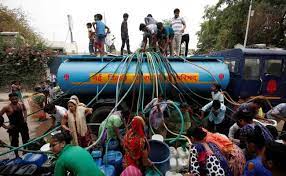High temperatures coupled with heat wave conditions has plagued the national capital with water crisis in many parts.
Delhi government on Thursday sent an SOS to Haryana urging to release additional water in the Yamuna river to prevent the water crisis in the city. “It is requested to supply 150 cusecs of raw water additionally through the DD-8/river route till the arrival of monsoon to ensure that 120 cusec of raw water reaches the Wazirabad pond in this time of crisis,” read the SOS sent to Haryana government.
Earlier, on May 3, Delhi Jal Board wrote to the Haryana Irrigation Department seeking additional water as the supply went critically low at Wazirabad and Haiderpur treatment plants triggering fear of disruption of water supply.
The capital city is among 21 cities of India which have probably exhausted the ground water resources. As per the NITI Ayog 2019 report, total 21 cities including Bangalore, Delhi, Hyderabad and Chennai have probably exhausted their groundwater resources in 2021.
“The NCT of Delhi, which is the largest metropolis in north India, has undergone explosive demographic expansion increasing pressure on water sources in various river basins in north India as well as on its internal groundwater resources. The small city state is high on consumption (with an insatiable demand), low on internal resource and high on externally dependence (mainly dependent on river Yamuna, Ganga, Bhakra Beas system – all snow fed a northern rivers),” reads the water policy of Delhi 2016.
The draft policy also adds that Delhi has limited options to influence developments outside its boundary. With restricted sources of supply, no addition to its supply is expected for at least next 10-15years.
Cause for crisis
Delhi is a landlocked city and receives raw water from neighbouring states like Haryana, Punjab and Uttar Pradesh. Yamuna water has been a contentious issue for a long time between Delhi and Haryana.
As per Delhi Jal Board, Haryana is releasing less water in Yamuna river. The DJB said that due to depletion of pond level of Yamuna at Wazirabad Water Works 671.80 feet against the normal level of 674.50 feet and reduction in release of raw water by Haryana in river Yamuna, water production has been affected from Water Treatment Plants at Wazirabad, Chandrawal and Okhla currently.
Delhi requires around 1,200 MGD of water, while the Delhi Jal Board supplies around 950 MGD. The government has now targeted increasing the water supply to 998 MGD to meet the growing demand this summer season and to 1,180 MGD by June 2023.
“Delhi’s water production has been maintained 900 MGD. Water is supplied to about 19.5 million population of Delhi through a water supply network comprising of 14355 km long pipelines and 107 primary Underground Reservoirs (UGRs) to ensure equitable water supply at sufficient pressure,” says DJB portal.
Source of water for Delhi
Two main water sources for Delhi are the Yamuna and Ganga which provides around 90 per cent of the water supply. The remaining 10 per cent is covered by ground water. Of these – Haryana and Uttar Pradesh are two main states that supply raw water through canals and channels.
East Delhi plants get raw water from the Ganga through pipelines stretching from Muradnagar in Uttar Pradesh, while Haryana supplies 610 million gallons of water a day to Delhi through two canals Carrier-Lined Channel (CLC) and Delhi Sub-Branch (DSB) and the Yamuna.
Yamuna river is a major source for water in Delhi. In 1994, a Memorandum of Understanding (MoU) was signed by the five basin states of the Yamuna, Delhi, Haryana, Himachal Pradesh, Rajasthan, and Uttar Pradesh for sharing its water of upper Yamuna.
However, Delhi being landlocked relies heavily on adjoining states for meeting much of its water needs.






















